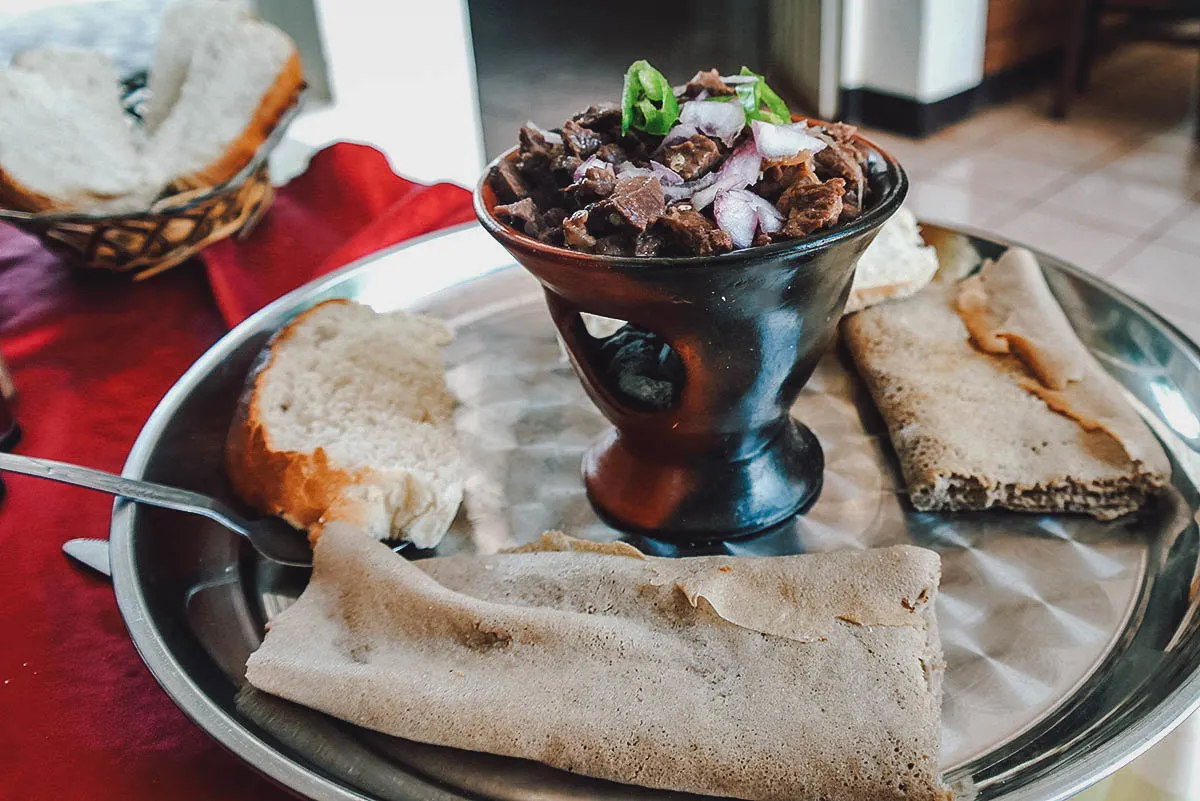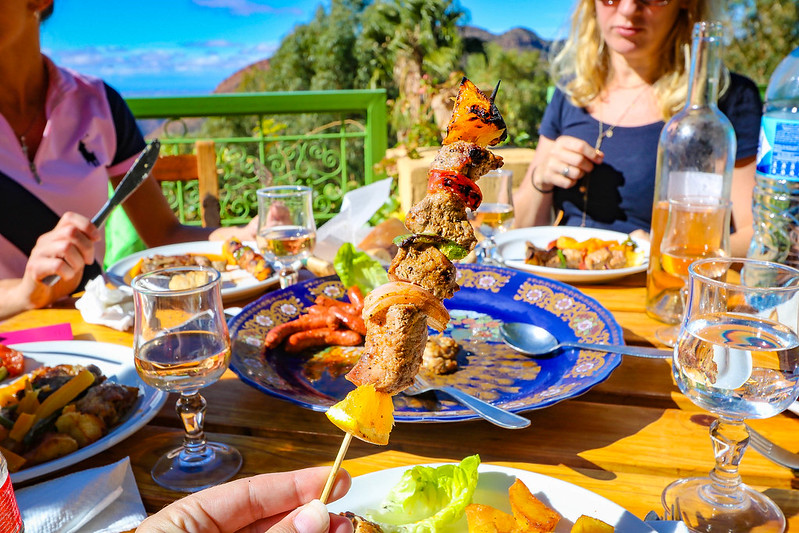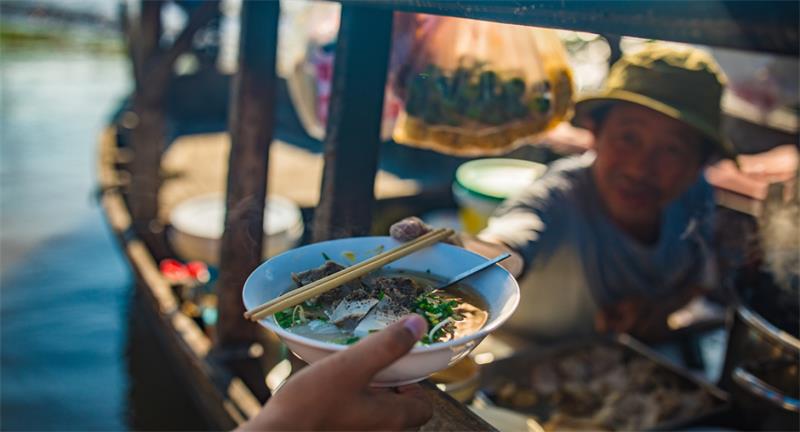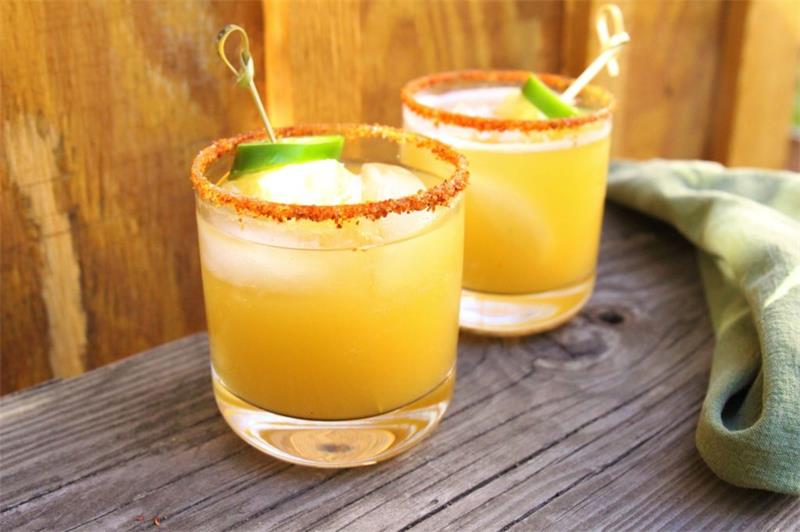Contents
Introduction
Ethiopia is a country with a rich and diverse food culture that is largely unknown to the rest of the world. The cuisine is characterized by its unique combination of spices, stews, and flatbreads.
Ethiopian food is more than just nourishment; it’s a representation of the country’s rich history and cultural diversity. Exploring new food cultures can be intimidating but also incredibly rewarding.
It allows individuals to expand their taste buds, learn about different traditions and customs, and gain a deeper understanding of a country’s culture. The beauty of discovering food cultures lies in the adventure and excitement that comes with it.
Brief overview of Ethiopia’s food culture
Ethiopian cuisine is heavily influenced by its geography, climate, history, religion, and culture. The majority of Ethiopian dishes are made from cereals such as teff (a small grain native to Ethiopia), barley, wheat flour or sorghum which are used to make injera – a spongy bread that serves as the backbone for most meals.
Ethiopian cuisine strongly emphasizes communal eating – dishes are served on large platters for everyone to share. Ethiopians eat with their hands using injera as both utensil and plate.
The diversity in ethnic groups has led to variations in cooking styles across Ethiopia’s various regions. Some dishes may be similar but have different names depending on where they are prepared.
Ethiopian Cuisine
Overview of Ethiopian cuisine and its unique characteristics
Ethiopian cuisine is one of the most unique and diverse food cultures in Africa. It has been influenced by various factors such as geography, religion, history, and native crops.
The cuisine is known for its bold flavors, aromatic spices, and a variety of vegetarian and non-vegetarian dishes. Injera bread is the staple food of Ethiopia which is eaten with almost every meal.
One of the unique characteristics of Ethiopian cuisine is how it is traditionally eaten. Ethiopian meals are usually served on a communal plate called a “messob” where everyone eats with their hands using pieces of injera bread as utensils to scoop up the food.
This social aspect of eating encourages bonding between family and friends over meals. Another notable feature of Ethiopian cuisine is its emphasis on vegetarian dishes.
Many Ethiopians follow religious fasting traditions that require them to abstain from meat for certain periods throughout the year. As such, there are numerous vegetarian dishes available in Ethiopian cuisine that are just as flavorful as their meat counterparts.
The role of spices in Ethiopian cooking
Spices play a crucial role in almost every dish in Ethiopian cuisine. One particular spice blend called “berbere” serves as the cornerstone flavor profile for many traditional dishes such as stews and grilled meats.
Berbere includes ingredients like chili peppers, garlic, ginger, coriander seeds, cumin seeds, cardamom pods, cinnamon sticks among other spices. Another essential ingredient used in many traditional dishes is niter kibbeh – a type of clarified butter that has been infused with various spices including garlic and ginger.
Niter kibbeh adds an incredible depth of flavor to any dish it’s used in. Moreover, most traditional spicy dishes are made using bird’s eye chili peppers which give them their signature fiery kick.
However, other spices like turmeric, cinnamon and black pepper also feature prominently in Ethiopian cuisine. Overall, the use of spices in Ethiopian cooking is integral to the flavor profile of the cuisine and is one of its distinguishing factors.
Traditional Ethiopian Dishes
Ethiopian cuisine is characterized by its unique flavors and techniques. The food culture of Ethiopia is heavily influenced by its geography, history, and religion.
It is therefore not surprising that traditional Ethiopian dishes are a reflection of this rich cultural heritage. Here are some of the most popular traditional dishes in Ethiopia:
Injera: The Staple Bread of Ethiopia
Injera is a sourdough flatbread that is central to Ethiopian cuisine. It is made from teff flour, which gives it a distinct flavor and texture.
Injera is typically used as both a plate and utensil during meals; diners tear off pieces of injera and use them to scoop up stews, curries, or salads. Making injera requires skill and patience as it goes through a fermentation process that can last for several days.
The result is a tangy bread with a spongy texture that pairs well with spicy or savory dishes. Injera can be served with any meal but is most commonly associated with breakfast.
Doro Wat: A Spicy Chicken Stew
Doro wat, also known as “the national dish of Ethiopia,” is a spicy chicken stew made with berbere spice blend, onions, garlic, ginger, and other spices. Berbere spice blend gives doro wat its reddish color and complex flavor profile.
The dish typically includes hard-boiled eggs and may be served with injera or rice on the side. Doro wat has become popular outside of Ethiopia due to its unique flavor profile; it’s one of the few African dishes that has gained international recognition.
Tibs: Grilled Meat Served with Vegetables
Tibs are grilled cubes of meat (typically beef) served alongside vegetables such as tomatoes, onions, peppers or collard greens. Tibs are usually seasoned with salt, pepper, cumin and other spices.
This dish can be served spicy or mild according to personal taste preferences. Tibs are popular in Ethiopia and can be found at many local restaurants.
They are often served with injera or bread on the side. Tibs have become a favorite of Ethiopians’ street food as well.
Shiro: A Chickpea or Lentil Stew
Shiro is a thick stew made from ground chickpeas or lentils that is seasoned with onions, garlic and spices such as berbere. It’s a vegan dish that is often eaten alongside injera or bread. Shiro has a nutty flavor and creamy texture that is perfect for dipping bread into.
It’s also a versatile dish that can be adapted to personal taste preferences by adding more spice for those who like it hot or more vegetables for those who prefer it hearty. Traditional Ethiopian dishes form the backbone of the country’s rich food culture.
From injera to doro wat, tibs to shiro, these dishes showcase the diverse flavors and influences that make Ethiopian cuisine unique. Trying these traditional dishes is an excellent way to discover Ethiopia’s history and its people through their food!
Regional Variations in Ethiopian Cuisine
Differences in cuisine between regions such as Amhara, Oromia, and Tigray
Ethiopia is a diverse country with over 80 different ethnic groups, each with their own unique language and culture. This diversity is reflected in the country’s cuisine, with variations in taste and preparation methods across different regions.
The three largest ethnic groups – the Amhara, Oromo, and Tigray – each have their own distinct culinary traditions. In Amhara cuisine, dishes are usually made with spicy berbere seasoning or mild mitmita seasoning.
Meat dishes are popular, including tibs (cubes of meat sautéed with onions and spices) and kitfo (raw beef minced and served like steak tartare). Vegetables such as collard greens are also commonly used.
Oromo cuisine features a lot of grains such as barley and millet. Spices like cardamom, cumin, ginger and turmeric are commonly used to flavor stews made from chicken or lamb.
Injera is still the staple food here but it’s typically eaten with porridge or bread made from sorghum. Tigrayan cuisine has a reputation for being spicy.
Alongside injera bread which is still widely consumed here too, they mostly rely on the use of Teff flour for their baking needs. As far as main dishes go there’s plenty to sample: tsebhi (stew), shiro (a chickpea stew), tibs wat (spicy beef) & kitcha fitfit (flavored shredded bread).
Unique dishes from each region
Beyond the regional differences in cooking styles mentioned above there are many specific dishes unique to certain regions throughout Ethiopia that reflect that area’s environment or customs. For example in Gojjam, a region of Amhara, the cuisine is characterized by sour and spicy flavors.
Gojjam-style tibs is an example of this cooking style, as it features small pieces of meat cooked in a spicy sauce made with berbere and tej (honey wine). In the Southern Nations, Nationalities, and Peoples’ Region (SNNPR), enset – also called “false banana” – is a staple food.
It’s prepared in various ways including being pounded into flour, which is then used to make porridge or bread. In the Afar region located in northeastern Ethiopia they rely heavily on milk and dairy products such as ayib (a type of cottage cheese) and ghee.
Dishes typical to this area include raw meat dishes like kurt or jijera. Exploring these regional differences in Ethiopian cuisine can introduce you to new flavors and unique dishes that you may not have experienced before.
Street Food Culture in Ethiopia
One of the best ways to experience the food culture of Ethiopia is by exploring its street food scene. Ethiopian street food is not only delicious but also affordable, making it accessible to everyone. Street vendors can be found all over the country, especially in cities like Addis Ababa and Gondar.
Overview of Street Food Culture in Ethiopia
Ethiopian street food is a reflection of the country’s diverse cultural heritage and geographic location. It combines flavors from Africa, the Middle East, and India. The most popular street foods are usually spicy and flavorful, made with fresh ingredients that are sourced locally.
Street vendors often set up their stalls along busy roadsides and marketplaces where locals can easily access their offerings. Ethiopians love snacking on street foods throughout the day, whether it’s for breakfast or a late-night snack after a night out with friends.
Popular Street Foods
Samosas are one of the most common street foods in Ethiopia. They are triangular-shaped pastries filled with spicy vegetables or meat that are deep-fried until crispy on the outside.
These tasty snacks can be enjoyed at any time of day and are often served with hot sauce for an extra kick. Roasted corn is another popular snack found on Ethiopian streets.
Corn cobs are roasted over an open flame until perfectly charred on the outside and tender on the inside. They’re usually brushed with spices and served piping hot with lime juice squeezed over them.
Fried plantains or banana chips are also widely available on Ethiopian streets. They’re thinly sliced green bananas that have been fried until golden brown and crispy then served alongside spicy dips or sauces.
If you want to truly experience the food culture of Ethiopia, exploring its street food scene is a must. These affordable and delicious snacks will give you a taste of Ethiopia’s diverse culinary heritage and leave you wanting more.
Coffee Culture in Ethiopia
Ethiopia is known as the birthplace of coffee, and the beverage is an integral part of Ethiopian culture. Coffee is not just a drink in Ethiopia; it is a ritual that brings people together.
Ethiopians have a unique way of roasting, brewing, and serving coffee that has been passed down through generations. It’s no surprise that when visiting Ethiopia, one must experience the coffee culture to truly understand the country’s love for this drink.
The Importance of Coffee in Ethiopian Culture
Coffee holds significant importance to Ethiopians and has been an integral part of their social and cultural traditions for centuries. The coffee ceremony is considered sacred, with great value placed on its role in bringing people together for conversation and community.
The beans are roasted over an open flame until they turn dark brown and release their aroma. Once roasted, the beans are ground by hand using a mortar and pestle known as a Jebena.
The grounds are then brewed in boiling water also boiled on an open flame using another pot called a Jebena. The coffee is served with popcorn or other snacks as a sign of hospitality.
Traditional Coffee Ceremonies
The traditional Ethiopian coffee ceremony takes place in homes or cafes throughout Ethiopia. Guests are welcomed into someone’s home where they will be invited to sit around the ceremonial area designated for brewing coffee. The host starts by washing fresh green beans before roasting them over hot coals while continuously stirring them until they reach the desired level of darkness.
Once roasted, the host grinds the beans by hand using a mortar and pestle before adding them into boiling water boiled in another pot called Jebena. As guests wait for their first cup to be served, they can enjoy snacks like popcorn or toasted barley (known as Kolo) which are served alongside each serving cup made from small ceramic cups.
Once the coffee is ready, the host serves it in small, handle-less cups called “sini” that are filled with a rich and fragrant brew. The ceremony ends when all guests have had at least three servings of coffee each.
Experiencing Ethiopian coffee culture is an essential part of visiting Ethiopia and understanding their unique traditions. Ethiopians take great pride in their coffee-making techniques and welcome visitors to partake in their ceremonial traditions with warmth and hospitality.
Ingredients Used in Ethiopian Cooking
Ethiopian cuisine is known for its unique and flavorful dishes that are often made with a variety of spices and ingredients. Here are three essential ingredients that are commonly used in Ethiopian cooking:
Teff flour: the main ingredient used to make injera bread
Injera is a staple bread in Ethiopian cuisine and is made using teff flour. Teff is an ancient grain that has been grown in Ethiopia for thousands of years and is rich in nutrients like calcium, iron, and protein.
Injera is a sourdough flatbread that has a slightly tangy taste due to the fermentation process. It’s eaten with almost every meal and often used as an edible utensil to scoop up stews, curries, and other dishes.
Teff flour can be found at specialty grocery stores or online retailers. If you’re unable to find teff flour, you can try substituting it with other gluten-free flours like rice or quinoa flour.
Berbere spice blend: a mixture of spices used to flavor many dishes
Berbere spice blend is a cornerstone ingredient in Ethiopian cooking and adds depth of flavor to many dishes. The blend typically includes hot chili peppers, garlic, ginger, cumin, coriander, cinnamon, cloves, cardamom, nutmeg, allspice berries, paprika powder or deghi mirch (hot red pepper powder), fenugreek seeds or leaves (Trigonella foenum-graecum), turmeric powder for the yellow color.
Berbere can be added to chicken stews like Doro Wat as well as vegetarian dishes such as lentil stews like Misir Wat or chickpea stews like Shiro. It’s also delicious sprinkled on grilled meats or roasted vegetables.
Niter Kibbeh: clarified butter infused with spices
Niter Kibbeh is a type of clarified butter that’s been infused with a variety of spices such as ginger, garlic, cinnamon, cardamom, and turmeric. It’s used in many Ethiopian dishes to add richness and depth of flavor.
Niter Kibbeh can be used in place of regular butter or oil when cooking vegetables, meats, or grains. To make your own Niter Kibbeh at home, simply melt unsalted butter in a saucepan over low heat.
Once the butter has melted and the milk solids have separated from the liquid fat, skim off the foam on top. Add in your desired spices and let them infuse for 10-15 minutes before straining out the solids and discarding them.
Where to Find Authentic Ethiopian Food
Ethiopian cuisine is becoming more popular around the world, but if you want to experience authentic Ethiopian food, it’s best to visit Ethiopia. There are many restaurants that serve traditional Ethiopian dishes in Addis Ababa, the capital city.
Some popular restaurants include Yod Abyssinia, Habesha 2000, and Fasika Ethiopian Restaurant. If you’re not in Addis Ababa, there are still opportunities to try authentic Ethiopian food.
Look for Ethiopian restaurants in your area or attend an Ethiopian food festival. Many cities around the world have annual festivals celebrating African culture that feature traditional foods from Ethiopia and other countries on the continent.
Another way to experience authentic Ethiopian food is by staying with a local family or participating in a homestay program while visiting Ethiopia. This will allow you to learn about their cooking methods and ingredients and even help prepare meals.
Conclusion
Exploring new food cultures can be a fun and rewarding experience. By discovering the rich and unique food culture of Ethiopia, you’ll not only satisfy your taste buds but also gain insight into the country’s history, traditions, and way of life. From injera bread to spicy stews like doro wat and tibs, there’s no shortage of delicious dishes to try in Ethiopia.
By exploring different regions of the country or attending street fairs featuring Ethiopian cuisine from around the world, you can broaden your culinary horizons even further. So take a chance on new flavors and experiences – who knows what amazing discoveries lie ahead?













